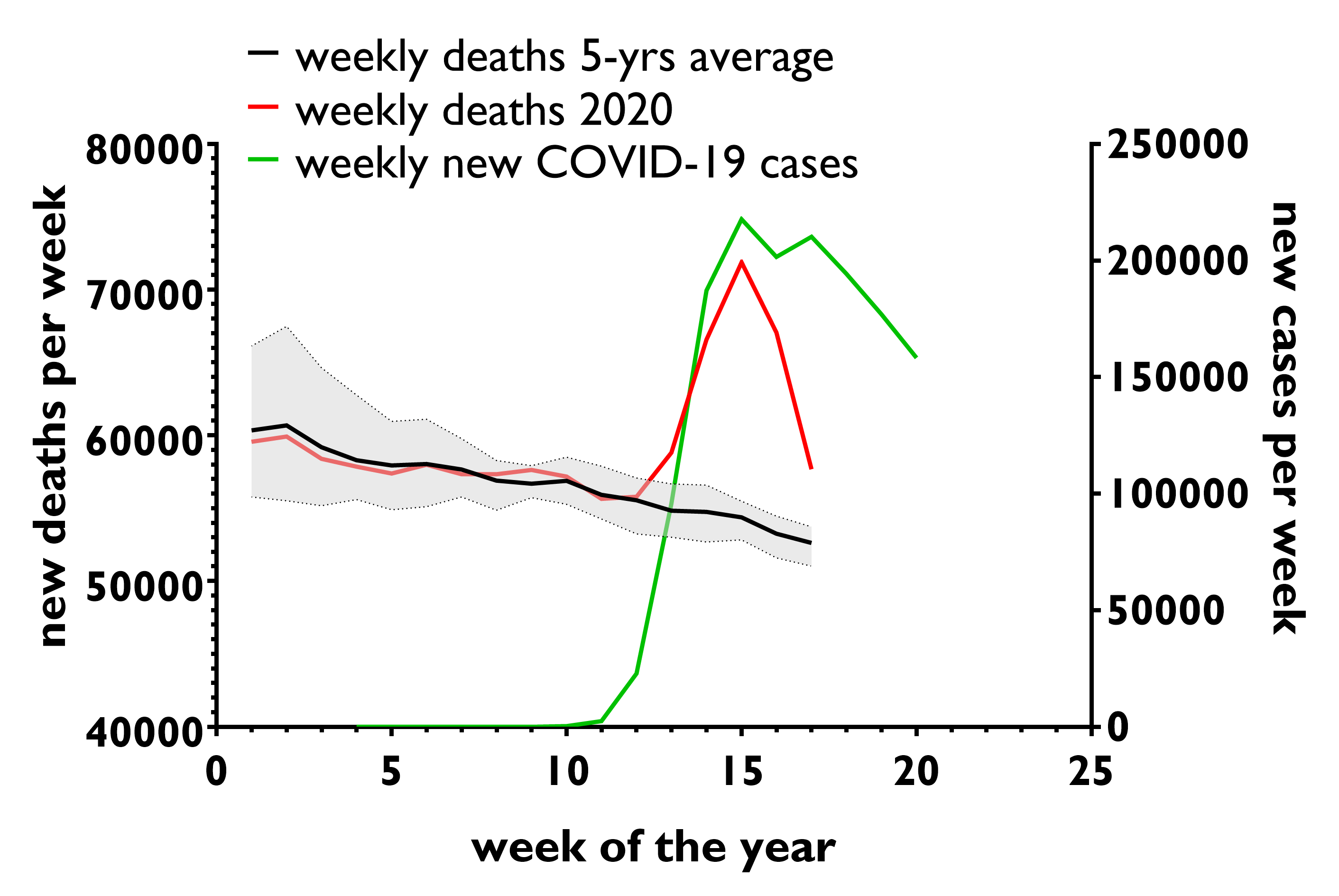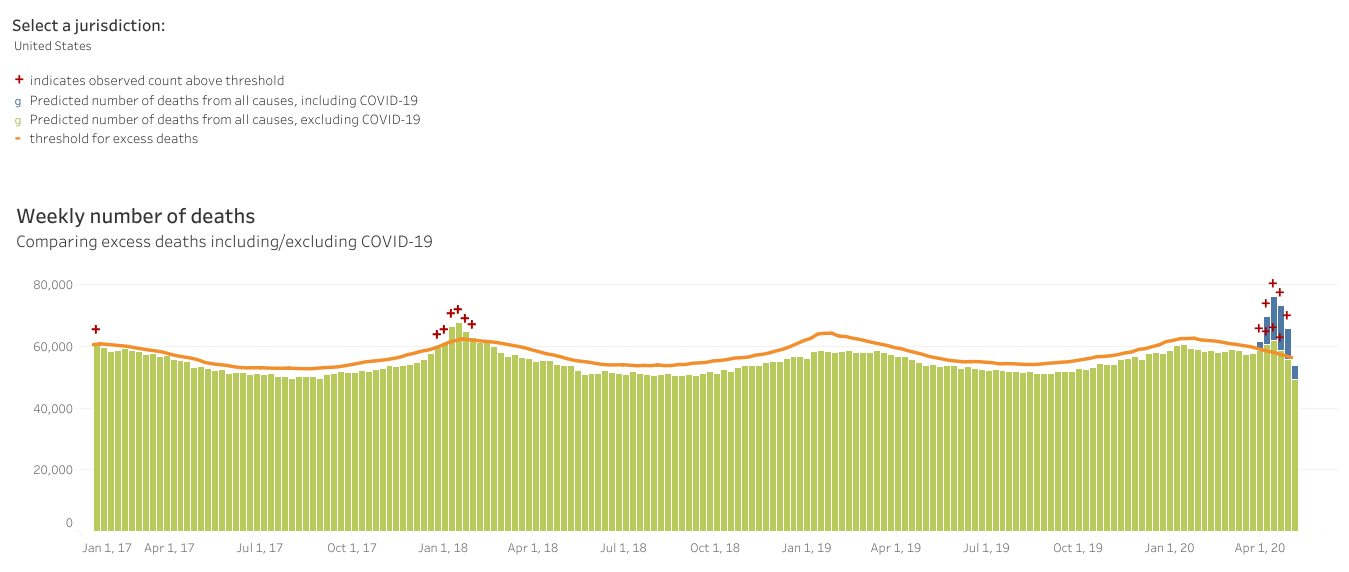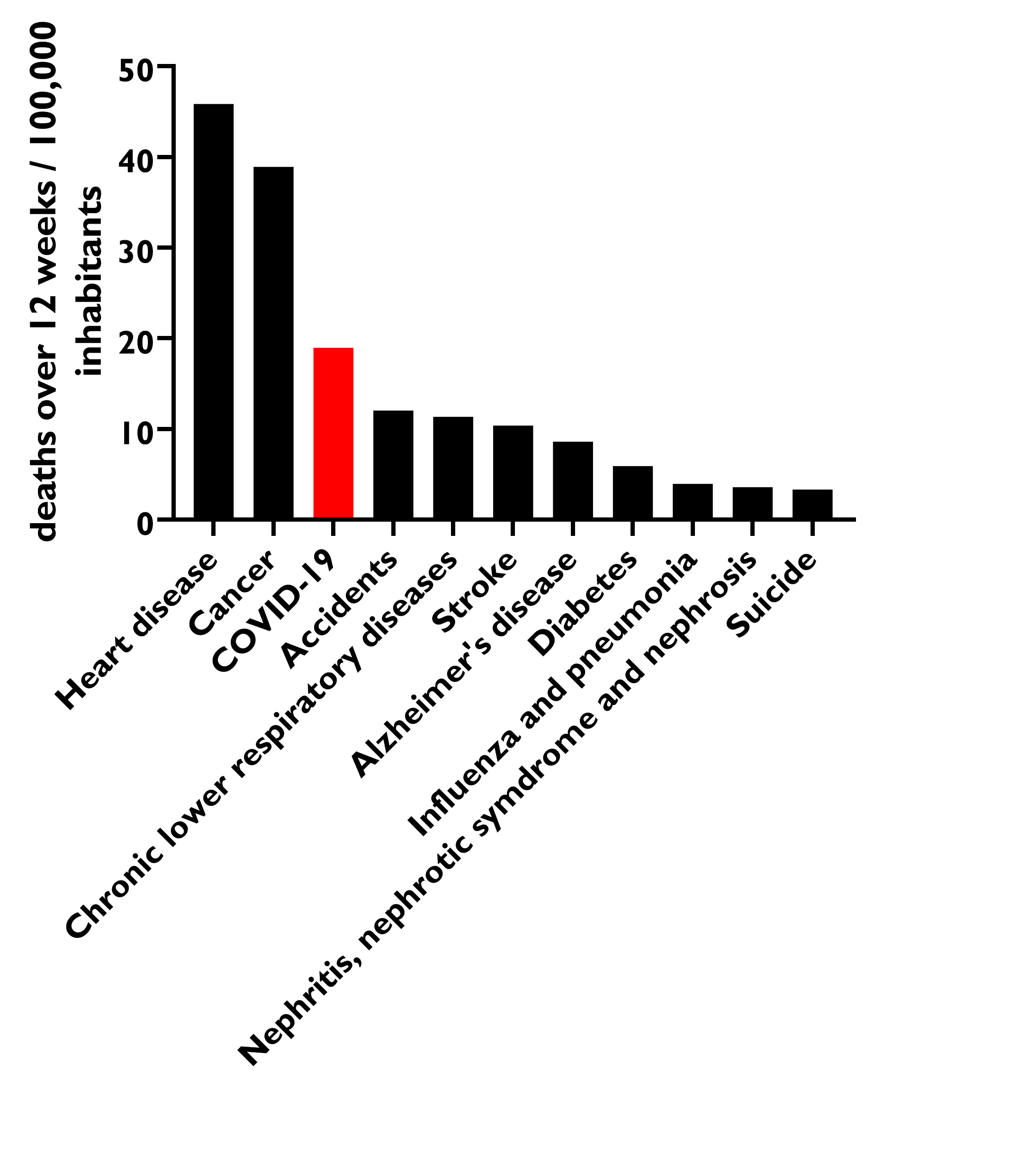
Lacks context : The post author neglected to explain that the CDC collects and reports death count data in a manner that results in underestimates in initial reports followed by rapid increases as new data becomes available.

FULL CLAIM: The U.S. is not losing “tons more lives” in 2020 compared to 2019. “Deaths in 2019: 973,344. Deaths in 2020: 991,777...[the] increase—virtually non-existent”.
SUMMARY
A post shared on Facebook on 13 May 2020 compared the number of deaths in the U.S. during the first 17 weeks of 2019 (30 December 2018 to 27 April 2019) to those during the same period in 2020 (29 December 2019 to 25 April 2020)@. The post states that the number of additional deaths in 2020 is “virtually non-existent”, or negligible. It further states that reports of high death counts are a “media illusion”. Allegations that the pandemic has had little to no impact on public health or mortality rates has been a recurring theme on social media.
The author of the post uses these data to support her objection to “lockdowns”, which have caused businesses to close temporarily to slow the spread of the COVID-19 pandemic. The claims thus call for three verifications: Are the reported figures accurate? Are the figures relevant to the claim that COVID-19 is having little impact on the U.S. mortality rate in 2020? Is the increased mortality rate in 2020 “non-existent”?
1. Are the reported figures accurate?
The post reports the cumulative number of deaths from all causes in the U.S. from week 1 of 2020 through week 17, as provided in the mortality surveillance data released during week 18 (ending 2 May 2020) by the National Center for Health Statistics (NCHS), a branch of the U.S. Centers for Disease Control and Prevention. At the time the post was written, the figures were indeed accurate.
However, the post fails to mention that the provided death counts were preliminary and therefore underestimated the actual death count. The NCHS collects death certificates from every state and releases a weekly summary of the number of deaths. In the reports, deaths are grouped according to the week that they occurred, but many deaths that occur during a given week are not registered and communicated in time to be included in the mortality surveillance data released during that week. Therefore, each new weekly release of mortality data not only includes the new death count for the week that just ended, but also updates the death counts for all previous weeks based on any new death certificates that are submitted.
As an example, the death count for week 10 of 2020 was reported as 56,652 in the NCHS release at the end of week 18, but was updated to 57,184 in the release at the end of week 19 (9 May). This means that 532 deaths that had occurred during week 10 were not communicated in time to be included in the week 18 release and were only added to the week 19 release. The death count for a particular week therefore continues to change with each weekly release of new data—a fact that the post’s author failed to take into account.The changes can be quite dramatic: The author used data for week 17 (19-25 April) that was reported during week 18—indicating 47,526 deaths. But this number jumped to 57,680 in the week 19 update—an additional 10,154 deaths.
To get an updated and more accurate picture of the death count in the U.S., Health Feedback used data from the week 19 release to reanalyze the death count from week 1 through week 17, which is the same period that was cited in the Facebook post (Figure 1). We compared the cumulative number of deaths in 2020 (red curve) to the average cumulative number of deaths that occurred during the first 17 weeks of the previous five years (2015 – 2019)#. This approach is more reliable than if we only consider the data from 2019. The figure below illustrates that the number of deaths in 2020 started to diverge from the average of the past five years at week 13. At week 15, it rose above the range of values for the previous five years (grey shaded area), indicating that 2020 is currently the deadliest year of the last six years (2015 – 2020).
This updated analysis thus shows that there has indeed been noticeably more deaths in 2020 compared to past years. For the first 17 weeks of 2020, total deaths from all causes numbered 1,014,090, which is an increase of 40,726 deaths (+4.2%) relative to 2019 and 50,069 (+5.2%) relative to the 5-year average.

2. Are the figures presented in the post relevant to the claim that COVID-19 is having little impact on the U.S. mortality in 2020?
In addition to using preliminary data that underestimated mortality, the author chose a time period for her analysis which includes deaths that occurred before the outbreak began in this U.S.—this has the effect of obscuring the magnitude of the impact of the outbreak on the mortality after it began.
In January, the best estimates indicate that the prevalence of COVID-19 cases in the U.S. was low to zero. The first officially recorded case of COVID-19 in the U.S. was on 19 January 2020[1], although some undetected cases may have occurred sporadically before that. The first local chain of transmission of SARS-CoV-2 was reported at the end of January[2] and the first death of a patient who tested positive for COVID-19 likely occurred in early February. As the CDC reports, the number of COVID-19-positive patients did not start to increase sharply until week 13 (22 – 28 March).
This means that 12 out of the 17 weeks chosen for analysis by the post’s author included few to no deaths from COVID-19. The chosen time window is therefore not appropriate for assessing the effect of the COVID-19 pandemic on mortality, because 70% of that time window included a period when the epidemic had not fully hit the U.S.
A more appropriate and representative way to analyze the mortality trend is to look at the weekly number of deaths over time, rather than the cumulative number of deaths, in order to spot any mortality in excess of what has typically been observed in previous years. This is similar to what the Financial Times reported in other countries. Figure 2 presents the weekly number of deaths in 2020 for weeks 1 to 17 as reported in the week 19 NCHS release, and compares these numbers to the average weekly number of deaths that occurred in the previous five years$. The number of new COVID-19 cases detected per week is also shown for reference and was obtained by aggregating the daily count of new cases from the GitHub repository of the Center for Systems Science and Engineering at Johns Hopkins University.

The figure clearly shows that the number of deaths per week in January and February 2020 was similar to previous years. Around mid-March, however, just after the week when the number of confirmed COVID-19 cases started to increase (green curve), the number of deaths from all causes per week in the U.S. increased dramatically to a level far above the average weekly mortality during the same time period for the previous five years. At week 15, the number of deaths per week in 2020 peaked at more than 70,000, which is around 20,000 more deaths per week than what would normally be expected (as shown by the black line representing the previous 5-year average). As mentioned above, the deaths in more recent weeks tend to be underreported, which could explain part of the downward trend in the most recent weeks.
Notably, the number of U.S. deaths from all causes started to drop beginning at week 15 after social distancing measures began being implemented in many states in mid-March, although the mortality rate still has not returned to baseline levels, even after more than two months of these measures. The number of new confirmed COVID-19 cases showed a similar downward trend.
The CDC similarly presented an estimate of the number of “excess deaths” for the 2017 to 2020 period&. The orange line in Figure 3 represents a threshold above which the number of deaths is abnormally high compared with the mortality for previous years in the country. The figure clearly shows that the period from week 13 to week 17 in 2020 experienced “excess deaths”, coinciding with the increase in COVID-19 infections in the U.S.

3. Is the increased mortality in 2020 really “non-existent”?
The Facebook post claims that the U.S. has not sustained “tons more deaths” in 2020 compared to the same time period in 2019. This statement is subjective and, as a result, is difficult to assess. The quantification of excess mortality by the CDC (Figure 3) shows that the percentage of weekly excess deaths during week 13 through week 17 in 2020 varied from 6% to 33% and peaked at week 15. For comparison, the peak of excess deaths recorded during the exceptionally strong flu epidemic during the winter of 2017-2018 only reached 11% (week 2 of 2018). This shows that the excess mortality that the U.S. experienced in April 2020 is far greater than that recorded during a particularly strong flu season.
Another way to grasp the magnitude of the increase in COVID-19-related excess deaths in 2020 is to compare the numbers to the death tolls arising from other major causes of death. Health Feedback analyzed the death count provided by the NCHS from the day of the earliest reported death, which appeared to have occurred during week 6, to the end of week 17, which marks the latest time point included in the analysis by the author of the Facebook post. This covers a period of 12 weeks from 2 February to 25 April. According to the provisional death count for COVID-19 provided in the 21 May 2020 update, the death toll for that period was 54,529 (if we included weeks 18-20, this number would reach 71,339). (Note that this figure was accurate at the time of this review’s publication and is subject to increase as new death certificates are continually processed by the CDC.)
Using the most recent data from the CDC on the leading causes of death in the U.S. during 2017, we can see that COVID-19 claimed more lives over the 12 weeks in which the outbreak was actively spreading in the U.S. (from week 6 through week 17) than accidents, stroke, diabetes, suicide, and other conditions (Figure 4) during an equivalent period of time, even after accounting for the population increase from 2017 to 2020%. STAT News reached a similar conclusion in an article published on 9 April, albeit with a different methodology. The fact that COVID-19 ranked third in the list of leading causes of death in the U.S. during the 12 weeks from February to the end of April shows that COVID-19 cannot be ignored as possible contributor to the unusual increase in the number of U.S. deaths, which as our calculations here demonstrate, was not “non-existent”.

In summary, the Facebook post correctly reported the total number of deaths in the U.S. from week 1 through week 17 at the time it was written, using data released in week 18. However, the author failed to mention that these were preliminary data from the CDC and that underestimated the actual death count. More accurate numbers released by the NCHS recently (week 19) show that the death count for the first 17 weeks of 2020 was higher than during the same time period in 2019 by an additional 40,726 deaths. This number is likely to continue to increase as more up-to-date data becomes available. This highlights the risk of reporting preliminary data without also presenting the proper caveats.
The post also compared mortality from a time period before the onset of the COVID-19 epidemic in the U.S., which obscured the magnitude of the increase in mortality post-onset. A weekly comparison of mortality in 2020 with previous years clearly illustrates that 2020 mortality was abnormally high and coincided with the number of confirmed COVID-19 cases.
Finally, the post suggests that the increased death count in 2020 compared with 2019 is “virtually non-existent”. While this assertion is subjective, it is nevertheless clear based on data analysis that the excess deaths in 2020, the year of the COVID-19 pandemic, were higher than during the flu epidemic of 2017-2018. The first 17 weeks of 2020 also saw more deaths due to COVID-19 than due to many other leading causes of death. These data make it hard to justify the characterization of the impacts of COVID-19 as “non-existent”.
A similar claim was made in a Gateway Pundit article stating that the total number of deaths in the U.S. “in March 2020 [was] down 15% from the average of [the] prior four years”. This claim is also misleading as it contains the same flaws that we explained above.
Firstly, the authors failed to either notice or mention that the numbers they used were underestimates of the real death count. As we explained above, each weekly release from the CDC updates the death counts from the previous weeks to account for the arrival of new death certificates. The authors used the release of week 13 to calculate the number of deaths from week 9 to week 12. This was the latest available data at the time of their analysis, but is nonetheless preliminary and bound to increase with later updates. Such preliminary data should not be used to draw conclusions about whether the death count increased or decreased in 2020 compared to previous years.
The latest available data, as of 30 May 2020, was released during week 21. Using the more accurate death counts contained in this release, the number of deaths during the period from week 9 to week 12 was updated from the preliminary count of 193,017 to 228,991. This updated number reflects a 1% increase in the number of deaths during this period compared to the average number of deaths for the previous four years during the same period. The authors’ estimate of a 15% decrease is erroneous because it used incomplete data.
Secondly, the authors used the death count in March to suggest that the COVID-19 epidemic was not a threat. At the time they wrote their article, the overall mortality in the U.S. indeed seemed only slightly higher than the average of the previous four years (based on the week 21 release of death counts). But this is because their analysis included the time period covering only the beginning of the epidemic in the U.S. Our Figure 2 shows that 2020 mortality did not begin to rise dramatically compared to previous years until April. Based on the week 21 death count release, the death toll in April (roughly, week 14 to week 17) was 280,357 in 2020 compared to the average of the previous four years (216,648). This amounts to a large and significant increase of 29%.
NOTES
@: The CDC numbers the weeks of the year as 1 to 52. Each week starts on a Sunday and ends on the following Saturday and are referred to either by number or by the date of the last day of the week.
#: The cumulative number of deaths at a given week was calculated by adding the number of new deaths that occurred during that week to the sum of all the deaths that occurred during the preceding weeks. The dataset used was the weekly release of week 19. Note that death counts are updated in each successive release by the NCHS. The 5-year average was calculated by averaging, week by week, the cumulative number of deaths for the years 2015 through 2019.
$: The number of deaths from all causes was directly obtained from the week 19 release of data by the NCHS. The number of deaths calculated for each week during the years 2015 to 2019 represent five data points each—one for each of the five years. The black curve in Figure 2 represents the average of the five death counts and the grey area represents the range covered by the raw values. Note that death counts are updated in each successive release by the NCHS. The number of daily COVID-19-positive tests was obtained from Johns Hopkins University. The daily numbers in a given week were summed to yield a weekly number. Note that this does not account for variations in the overall number of tests carried out. However, the CDC reports the proportion of positive results among the tests carried out by public health laboratories and clinical laboratories and also indicates a sharp increase in the percentage of COVID-19-positive patients from week 12 through week 13 of 2020.
&: The number of deaths in Figure 3 are labeled “predicted number of deaths” because the raw number of deaths collected by the CDC are being weighted in order to account for any underreporting of death certificates that may occur. More details are available in this technical note.
%: The number of COVID-19 deaths were directly obtained from the 21 May provisional NCHS count. The number of deaths from other leading causes of death during a 12-week period was estimated from the total number of deaths from each cause during a full year (52 weeks).
REFERENCES
- 1 – Holshue et al. (2020) First Case of 2019 Novel Coronavirus in the United States. The New England Journal of Medicine.
- 2 – Ghinai et al. (2020) First known person-to-person transmission of severe acute respiratory syndrome coronavirus 2 (SARS-CoV-2) in the USA. The Lancet.
UPDATE (26 May 2020)
Based on comments received by Health Feedback, this review has been updated to clarify that the reduction in the number of deaths observed in the most recent weeks of 2020 could partly be due to the underreporting of death certificates to the CDC, a bias that we accounted for and explained extensively in the review. We updated the graph shown in Figure 4 so that it displays the number of deaths from each leading cause of death per 100,000 inhabitants. This allows us to account for the increase in population size between 2017 and 2020. This update does not modify our original verdict.
UPDATE (2 June 2020)
A discussion of a similar claim made by another author was added at the bottom of the review.


